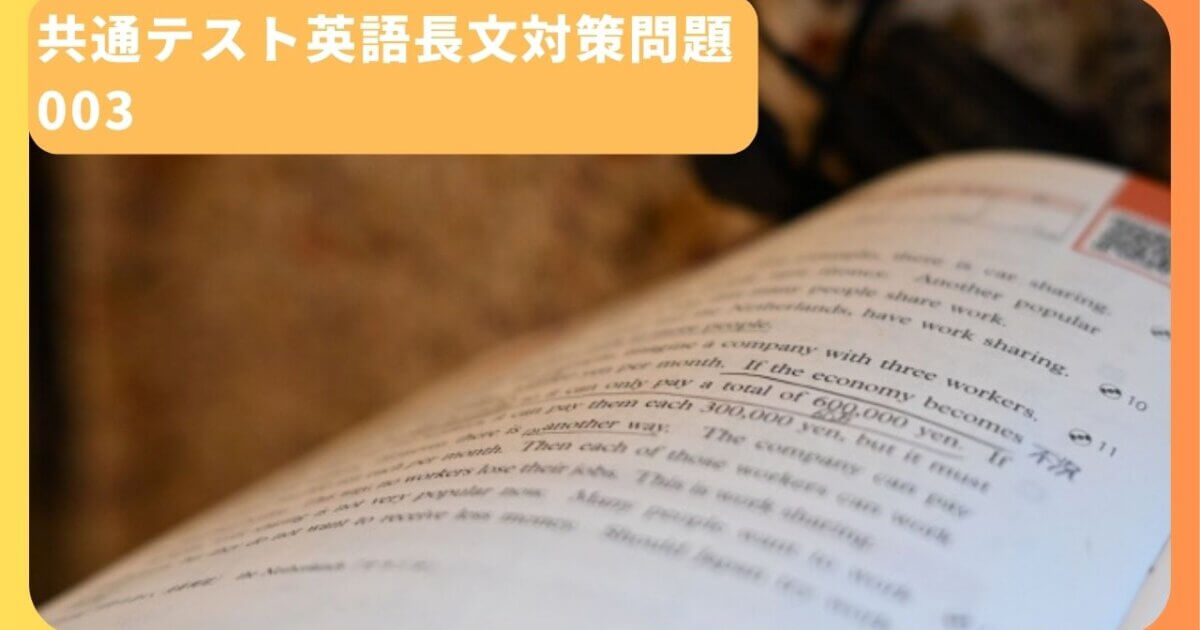共通テストで差がつく。英語の長文対策問題を公開しています。以下の制限時間内にすべての問題が解けるようにトレーニングしていきましょう。その際にわからない単語などは復習の際にしっかりと覚えることが重要です。
⭕️さらにもっと同様な共通テスト用の長い長文問題を無料配信しています。以下からLINE登録してください。毎日20日間配信します。https://kli.jp/f/saYH/

記事の監修者:五十嵐弓益(いがらし ゆみます)
【全国通信教育】最短合格オンラインのスカイ予備校 校長
■小論文指導歴27年
これまでに指導した生徒は4000人以上、独自のSKYメソッドを考案で8割取る答案の作り方を指導。
2020年4月から、完全オンラインの大学受験予備校となる。過去3年間で国公立大学合格85名。
高1から入会者は国公立大学合格率93%
高2から入会者は国公立大学合格率86%
高3の4月から入会者は国公立大学合格率73%。
スカイ予備校の指導方針は、「大人になっても役に立つ勉強法の習得」です。「自分の人生は自分で切り拓く」教育をします
英文500ワード003
以下の英文を読み、設問に答えよ(制限時間目標10分)
**The Impact of Plastic Pollution on Marine Life**
Plastic pollution has become one of the most pressing environmental issues of our time, especially in marine ecosystems. Every year, millions of tons of plastic waste enter the oceans, posing a significant threat to marine life. Plastics, which are non-biodegradable, can persist in the environment for hundreds of years. Over time, they break down into smaller particles known as microplastics, which are now found in nearly every corner of the world’s oceans.
Marine animals are particularly vulnerable to plastic pollution. Many species mistake plastic debris for food, which can lead to severe health problems or even death. For example, sea turtles often confuse plastic bags with jellyfish, one of their primary food sources. When they ingest these plastics, it can block their digestive systems, causing them to starve. Similarly, seabirds are known to feed plastic fragments to their chicks, mistaking them for small fish or other prey. This ingestion of plastic can cause malnutrition, internal injuries, and poisoning due to the toxic chemicals contained in plastics.
The problem is not limited to large marine animals. Microplastics, which are tiny pieces of plastic less than five millimeters in size, have been found in the stomachs of many smaller fish and invertebrates. These tiny organisms are often consumed by larger predators, which means that plastics can move up the food chain. As a result, even humans are at risk of ingesting microplastics when they eat seafood. Scientists are still studying the long-term effects of microplastics on human health, but early research suggests that they may disrupt hormones, cause inflammation, and carry harmful bacteria.
Another concern related to plastic pollution is the damage it causes to marine habitats. Coral reefs, which are home to some of the most diverse ecosystems on the planet, are particularly affected. When plastic debris settles on coral, it can block sunlight and limit the coral’s ability to perform photosynthesis. Additionally, plastics can cause physical damage to the coral structure, making it more vulnerable to diseases and reducing its ability to support marine life.
Efforts to combat plastic pollution are increasing, but much more needs to be done. Many countries have implemented bans on single-use plastics, such as straws, bags, and cutlery. These measures are a step in the right direction, but they are not enough to solve the problem entirely. Global cooperation is essential, as plastic pollution does not respect national borders. It requires a concerted effort from governments, industries, and individuals to reduce plastic waste and protect marine ecosystems.
One of the most effective ways to reduce plastic pollution is by promoting the use of alternative materials. Biodegradable plastics, reusable containers, and packaging made from renewable resources such as paper or bamboo are becoming more widely available. However, these alternatives are not yet as widespread or affordable as traditional plastics. Increased investment in research and development is needed to make these alternatives more accessible to the general public.
In conclusion, plastic pollution poses a serious threat to marine life and ecosystems. From large animals like sea turtles and seabirds to tiny organisms like plankton, the impact of plastics is far-reaching and potentially devastating. While efforts to reduce plastic waste are growing, much more must be done to address this global crisis. Only through collective action can we hope to protect the oceans and the countless species that depend on them.
問題
**問題 1**
What is one of the effects of plastic ingestion on sea turtles mentioned in the passage?
**選択肢**
1. Improved digestion
2. Increased energy
3. Blockage of the digestive system
4. Faster growth
5. Enhanced immune system
**問題 2**
What is a potential consequence of microplastics moving up the food chain?
**選択肢**
1. They are removed from the ocean.
2. Larger animals, including humans, may ingest them.
3. Microplastics disappear after digestion.
4. Microplastics help fish grow faster.
5. Microplastics turn into useful nutrients.
**問題 3**
How do plastics affect coral reefs according to the passage?
**選択肢**
1. Plastics help corals grow.
2. Plastics block sunlight and cause damage to coral structures.
3. Plastics increase coral reproduction rates.
4. Plastics protect corals from diseases.
5. Plastics clean the water around coral reefs.
**問題 4**
What is one of the measures countries have taken to reduce plastic pollution?
**選択肢**
1. Banning single-use plastics like straws and bags.
2. Encouraging more plastic production.
3. Dumping plastic into the ocean.
4. Increasing the use of plastic bottles.
5. Exporting plastic waste to other countries.
**問題 5**
Why are alternative materials important in fighting plastic pollution?
**選択肢**
1. They are cheaper to produce than plastic.
2. They can replace plastics that do not decompose.
3. They help plastic decompose faster.
4. They prevent plastic from entering the ocean.
5. They encourage people to use more plastic.
解答と解説
**問題 1 **
文章で言及されている、ウミガメがプラスチックを摂取した際の影響の一つは何ですか?
**選択肢 **
1. 消化の改善
2. エネルギーの増加
3. 消化器系の詰まり
4. 成長の促進
5. 免疫システムの強化
**解答 1**
3. 消化器系の詰まり
**解説 1**
文章では、ウミガメがプラスチックを食べると、それが消化器系を詰まらせることがあり、これが餓死につながる可能性があると述べられています。そのため、選択肢3が正解です。消化器系の詰まりは、プラスチック摂取の重大な影響の一つとして挙げられています。
**問題 2 **
マイクロプラスチックが食物連鎖を上昇することによる潜在的な結果は何ですか?
**選択肢 **
1. それらは海から除去される。
2. 大型の動物や人間がそれらを摂取する可能性がある。
3. マイクロプラスチックは消化後に消える。
4. マイクロプラスチックは魚の成長を助ける。
5. マイクロプラスチックは有用な栄養素に変わる。
**解答 2**
2. 大型の動物や人間がそれらを摂取する可能性がある。
**解説 2**
マイクロプラスチックは、食物連鎖を通じて魚や他の海洋生物に取り込まれ、最終的に人間を含むより大きな捕食者にも影響を与える可能性があります。このことは、健康に対するリスクをもたらす可能性があり、選択肢2が正解です。
**問題 3 **
文章によると、プラスチックはサンゴ礁にどのように影響を与えますか?
**選択肢 **
1. プラスチックはサンゴの成長を助ける。
2. プラスチックは日光を遮り、サンゴの構造に損害を与える。
3. プラスチックはサンゴの繁殖率を上昇させる。
4. プラスチックはサンゴを病気から守る。
5. プラスチックはサンゴ礁周辺の水を浄化する。
**解答 3**
2. プラスチックは日光を遮り、サンゴの構造に損害を与える。
**解説 3**
文章では、プラスチックがサンゴに堆積し、日光を遮ることで光合成ができなくなり、またサンゴの構造に物理的な損傷を与えると述べられています。これにより、サンゴ礁が病気にかかりやすくなるため、選択肢2が正解です。
**問題 4 日本語訳**
プラスチック汚染を減らすために各国が取った措置の一つは何ですか?
**選択肢**
1. ストローや袋などの使い捨てプラスチックを禁止する。
2. プラスチック生産を奨励する。
3. プラスチックを海に廃棄する。
4. プラスチックボトルの使用を増やす。
5. プラスチック廃棄物を他国に輸出する。
**解答 4**
1. ストローや袋などの使い捨てプラスチックを禁止する。
**解説 4**
文章では、多くの国が使い捨てプラスチック(ストローや袋など)を禁止することで、プラスチック汚染の問題に対処しようとしていると述べられています。この措置は、プラスチック廃棄物の削減に向けた一歩です。
**問題 5 **
プラスチック汚染と戦う上で代替素材が重要である理由は何ですか?
**選択肢**
1. プラスチックよりも生産コストが安いから。
2. 分解しないプラスチックを置き換えることができるから。
3. プラスチックの分解を早めるから。
4. プラスチックが海に入るのを防ぐから。
5. 人々がより多くのプラスチックを使うように促すから。
**解答 5**
2. 分解しないプラスチックを置き換えることができるから。
**解説 5**
文章では、生分解性プラスチックや再生可能な素材が、分解しない従来のプラスチックの代わりとして重要であると述べられています。これにより、プラスチック汚染を減らすことが期待されているため、選択肢2が正解です。
全訳
**海洋生物に対するプラスチック汚染の影響**
プラスチック汚染は、特に海洋生態系において、現代における最も深刻な環境問題の一つとなっています。毎年、数百万トンのプラスチック廃棄物が海に流れ込み、海洋生物に重大な脅威をもたらしています。プラスチックは生分解性がないため、環境中に数百年も残留する可能性があります。時間が経つにつれて、プラスチックは微小な粒子、いわゆるマイクロプラスチックに分解され、今では世界中の海のほぼすべての場所で見つかっています。
海洋生物はプラスチック汚染に対して特に脆弱です。多くの種がプラスチックの破片を餌と間違え、それが深刻な健康問題や死につながることがあります。たとえば、ウミガメはプラスチック袋を主食であるクラゲと勘違いすることがよくあります。これらのプラスチックを摂取すると、消化管が詰まり、餓死してしまうことがあります。同様に、海鳥は小魚や他の獲物と間違えてヒナにプラスチック片を与えることが知られています。このようなプラスチックの摂取は、栄養失調、内臓の損傷、そしてプラスチックに含まれる有毒化学物質による中毒を引き起こす可能性があります。
問題は大型の海洋動物に限られません。5ミリメートル未満の小さなプラスチック片であるマイクロプラスチックは、多くの小魚や無脊椎動物の胃の中で発見されています。これらの小さな生物は大型の捕食者に食べられることが多いため、プラスチックは食物連鎖を上昇することになります。その結果、魚介類を食べる人間もマイクロプラスチックを摂取するリスクにさらされています。科学者たちはマイクロプラスチックが人間の健康に与える長期的な影響をまだ研究中ですが、初期の研究では、ホルモンの乱れや炎症、さらには有害な細菌を運ぶ可能性があることが示唆されています。
また、プラスチック汚染が海洋の生息地に与える被害も懸念されています。地球上で最も多様な生態系の一つであるサンゴ礁は、特に影響を受けやすいです。プラスチックのゴミがサンゴの上に堆積すると、日光を遮り、サンゴが光合成を行う能力が制限されます。さらに、プラスチックはサンゴの構造に物理的な損傷を与え、病気にかかりやすくなり、海洋生物を支える力が低下します。
プラスチック汚染に対抗するための取り組みは増えていますが、まだ多くのことが必要です。多くの国では、ストローや袋、カトラリーなどの使い捨てプラスチックを禁止する法律が施行されています。これらの対策は一歩前進ですが、問題を完全に解決するには不十分です。プラスチック汚染は国境を越える問題であり、世界的な協力が不可欠です。政府、産業界、個人が協力してプラスチック廃棄物を減らし、海洋生態系を保護するための努力が必要です。
プラスチック汚染を減らすための最も効果的な方法の一つは、代替素材の利用を促進することです。生分解性プラスチックや再利用可能な容器、紙や竹などの再生可能な資源から作られた包装材が広く利用されるようになっています。しかし、これらの代替品はまだ従来のプラスチックほど広まっておらず、価格も高いです。これらの代替品をより一般的にし、誰もが利用できるようにするためには、研究開発へのさらなる投資が必要です。
結論として、プラスチック汚染は海洋生物と生態系に対して深刻な脅威をもたらしています。ウミガメや海鳥のような大型の動物からプランクトンのような微小な生物まで、プラスチックの影響は広範囲にわたっており、壊滅的な結果をもたらす可能性があります。プラスチック廃棄物を減らす努力が進んでいる一方で、この世界的な危機に対処するためには、さらなる行動が必要です。私たちが海洋とそこに依存する無数の種を守るためには、集団的な行動が不可欠です。




